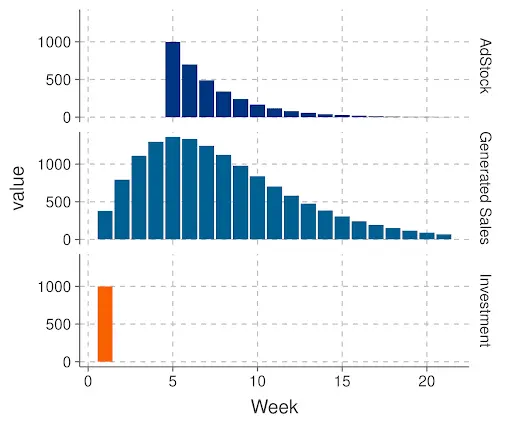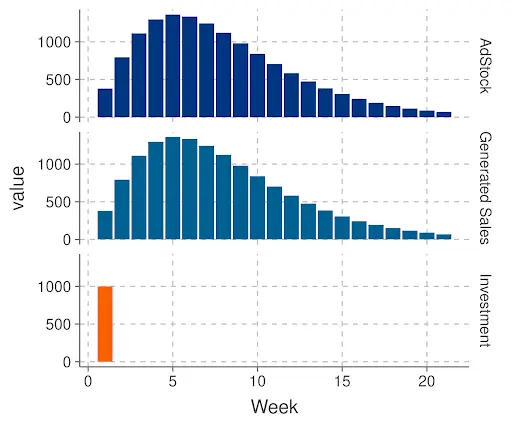
Introduction
When it comes to marketing effectiveness, one of the key challenges is understanding how the impact of advertising evolves over time. In marketing mix models (MMMs), this is addressed through what’s known as the adstock effect. The adstock effect refers to the notion that the influence of an advertisement is not limited to the day it’s aired but instead carries over for a period of time, gradually decaying as consumers respond to the message.
In this article, we’ll dive deeper into the adstock effect, explore why it’s crucial for accurate marketing attribution, and discuss different types of adstock models that can be used to better capture the real-world impact of advertising campaigns.
The Basics of Adstock: A Delayed Advertising Impact
Think about your own behavior when you encounter an advertisement. You might not rush to purchase a product the moment you see the ad. Perhaps you see a few more ads over the following days before you even consider taking action. This delay between the exposure to an advertisement and the eventual purchase decision is the core concept behind the adstock effect.
In traditional MMMs, adstock is used to model how the impact of media decays over time. When a company runs an ad campaign, the full impact isn’t seen immediately it spreads out over days, weeks or even months. Adstock helps to quantify this delayed response, allowing marketers to measure the cumulative impact of their media spend, rather than attributing all effects to a single day.
Why Adstock Matters in Marketing Mix Models
Capturing the adstock effect is essential because it provides a more accurate picture of how advertising drives sales or other KPIs. Without accounting for adstock, models would mistakenly attribute all results to the moment the ad is shown, ignoring the long-term effects and consumer behavior patterns that come afterward.
Incorporating Offline Channel Effects
Offline channels like TV, radio, and print have longer-lasting effects that aren’t immediately visible. Adstock captures these extended impacts, allowing you to attribute sales correctly to these channels, even if the results unfold days or weeks after the ad airs. This ensures a fair assessment of offline media’s contribution to your overall marketing success.
Adjusting for Delayed Conversions
Consumers often take time to make a purchase decision, especially for higher-value products. Adstock helps adjust for this delay by accounting for the continued influence of an ad long after its initial exposure. This is crucial for understanding the true performance of campaigns with longer purchase cycles, ensuring better long-term planning.
Better Budget Allocation
By factoring in the prolonged effects of advertising, adstock allows you to allocate your marketing budget more effectively. You can avoid prematurely cutting investments in channels that generate sales over time, ensuring your spending aligns with the actual contribution each channel makes to your business goals.
Types of Adstock Models
There are various ways to model the adstock effect, each providing different assumptions about how advertising impacts consumer behavior over time. Below are three common adstock models and their key characteristics:
Traditional Adstock: Immediate Impact with Decay
In a traditional adstock model, the effect of an advertisement is felt most strongly on the day it is aired, with its influence rapidly decaying in the following days. This model assumes that most consumers will respond right away, with fewer and fewer responding over time.

For instance, if a shoe retailer runs an ad on a Monday, the largest portion of sales would be expected on Monday, with sales tapering off on Tuesday, Wednesday, and so on. The decay is typically modeled using a geometric decay function, which assumes that each subsequent day has a lower impact than the day before.
While useful in many cases, traditional adstock oversimplifies consumer behavior. It’s rare that all consumers act immediately, especially for high-consideration purchases like cars or luxury goods.
Delayed Adstock: Shifted Response
In contrast to the traditional adstock model, the delayed adstock assumes that the peak effect of an advertisement happens later, rather than on the day it is aired. This might occur if an ad runs late in the day or if consumers are more likely to act after some consideration time.

For example, if a restaurant runs a late-night TV ad, customers may see the ad but won’t visit until the next day when the restaurant is open. The delayed adstock model shifts the peak effect into the future, better capturing scenarios where immediate action is unlikely.
However, even delayed adstock models can struggle to capture more nuanced responses where consumer action is spread out over multiple days in unpredictable ways.
Advanced Adstock: Ramp-Up and Ramp-Down
To address the limitations of both traditional and delayed adstock, advanced adstock models aim to provide a more flexible representation of advertising impact. These models incorporate both a ramp-up and ramp-down phase, reflecting how some consumers may act quickly while others take longer.

For example, after seeing an ad for a smartphone, one consumer might buy the phone immediately, while another may take weeks of research before making a decision. An advanced adstock model allows for this variation by simulating both an early surge in sales and a more gradual, long-term effect. This model is especially useful for omni-channel marketing, where consumers may interact with a brand through multiple touchpoints before converting.
By better reflecting real-world behavior, advanced adstock models provide a more accurate picture of how media influences sales over time, particularly for high-involvement purchases.
Applying Adstock to Offline and Online Channels
It’s also worth noting that the adstock effect isn’t limited to digital advertising it applies equally to offline channels like TV, radio, and out-of-home (OOH) ads. For example, a billboard might generate awareness on the first day, but its full impact may not be realized until consumers pass it multiple times over the course of a week.
In fact, adstock models can be even more crucial for offline channels because their effect is often harder to measure directly. While online channels can offer immediate feedback through metrics like click-through rates (CTR) or conversions, offline channels rely on indirect measures, such as foot traffic or sales spikes, which can take longer to manifest.
MMM, when equipped with robust adstock models, helps businesses understand how their offline investments are paying off by modeling the carryover effects of each campaign. This is especially valuable in the current digital privacy landscape, where traditional user-level tracking is becoming increasingly difficult, and marketers must rely more heavily on aggregated data and statistical methods like MMM.
Optimizing Marketing Strategy with Adstock Insights
Armed with the right adstock model, marketers can make more informed decisions about their media spend. Understanding how long the impact of an ad lasts and how it decays can help in several areas:
- Frequency Capping: Avoid wasting budget by oversaturating a channel after its impact has peaked.
- Campaign Timing: Plan more effective campaigns by knowing when a fresh wave of ads is needed to sustain sales momentum.
- Cross-Channel Insights: Evaluate how different channels (e.g., TV vs. digital) have varying adstock effects, allowing for better coordination of omni-channel campaigns.
By taking the adstock effect into account, MMM becomes a far more powerful tool for optimizing not just current campaigns but future ones as well.
Conclusion: Adstock as a Key Component of Advanced MMM
The adstock effect is fundamental to understanding how marketing works in the real world. By accurately modeling how the impact of advertising decays over time, marketers can make more strategic decisions, avoid over-investing in certain channels, and maximize the return on their media spend.
Whether using traditional, delayed, or advanced adstock models, incorporating this concept into your marketing mix models is essential for capturing the full effect of your campaigns both online and offline.